Project Management: Methodologies, Gantt Chart, Stakeholder Analysis, WBS, Risk Assessment
VerifiedAdded on 2023/06/18
|17
|2151
|90
AI Summary
This report presents project management techniques and tools for effective project operations. It covers methodologies, Gantt chart, stakeholder analysis, WBS, and risk assessment. The report is based on a project undertaken by Transport for London to construct land and create more than 800 new homes in Acton. The report provides insights into effective project operations and techniques for ensuring long-term existence in the market.
Contribute Materials
Your contribution can guide someone’s learning journey. Share your
documents today.
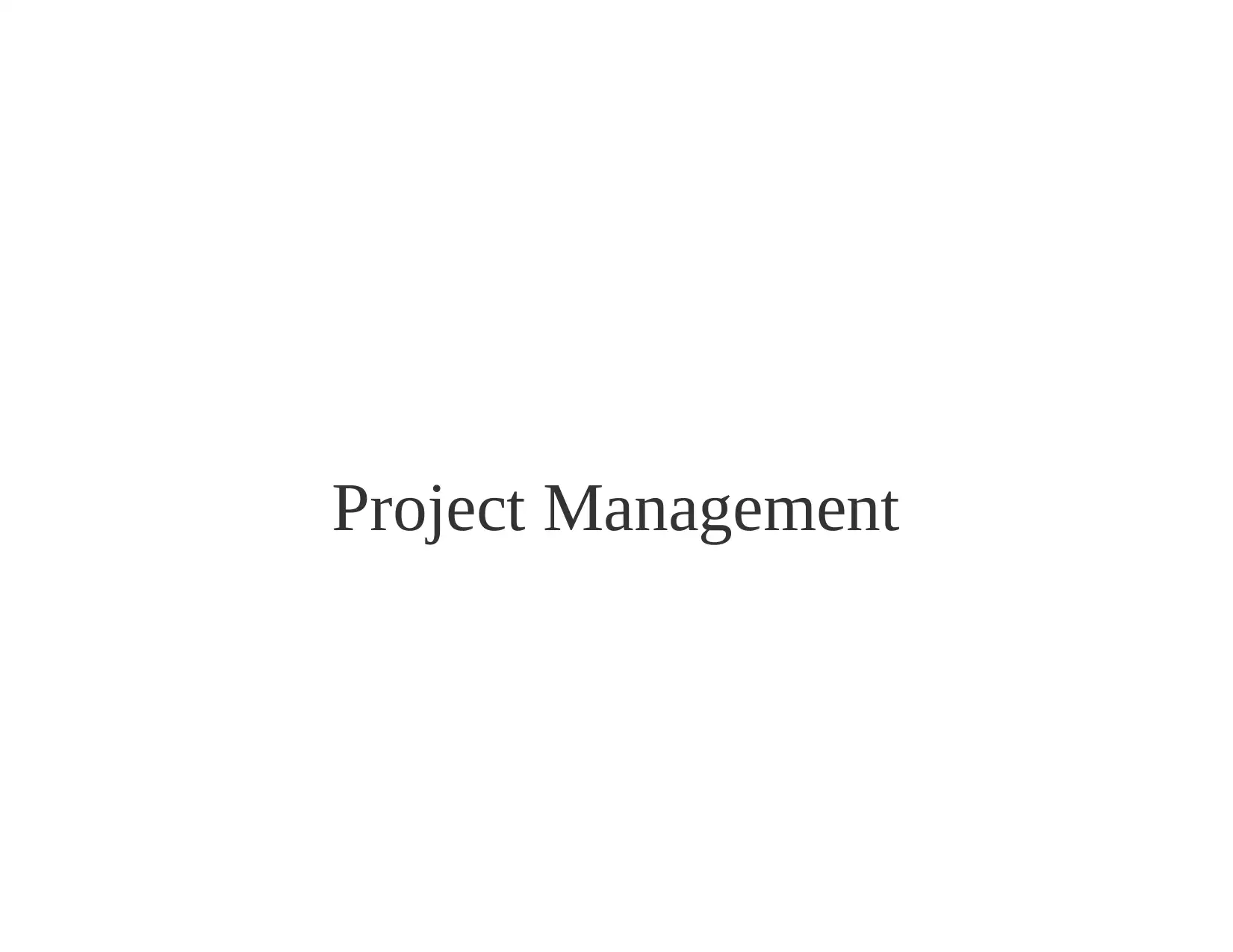
Project Management
Secure Best Marks with AI Grader
Need help grading? Try our AI Grader for instant feedback on your assignments.
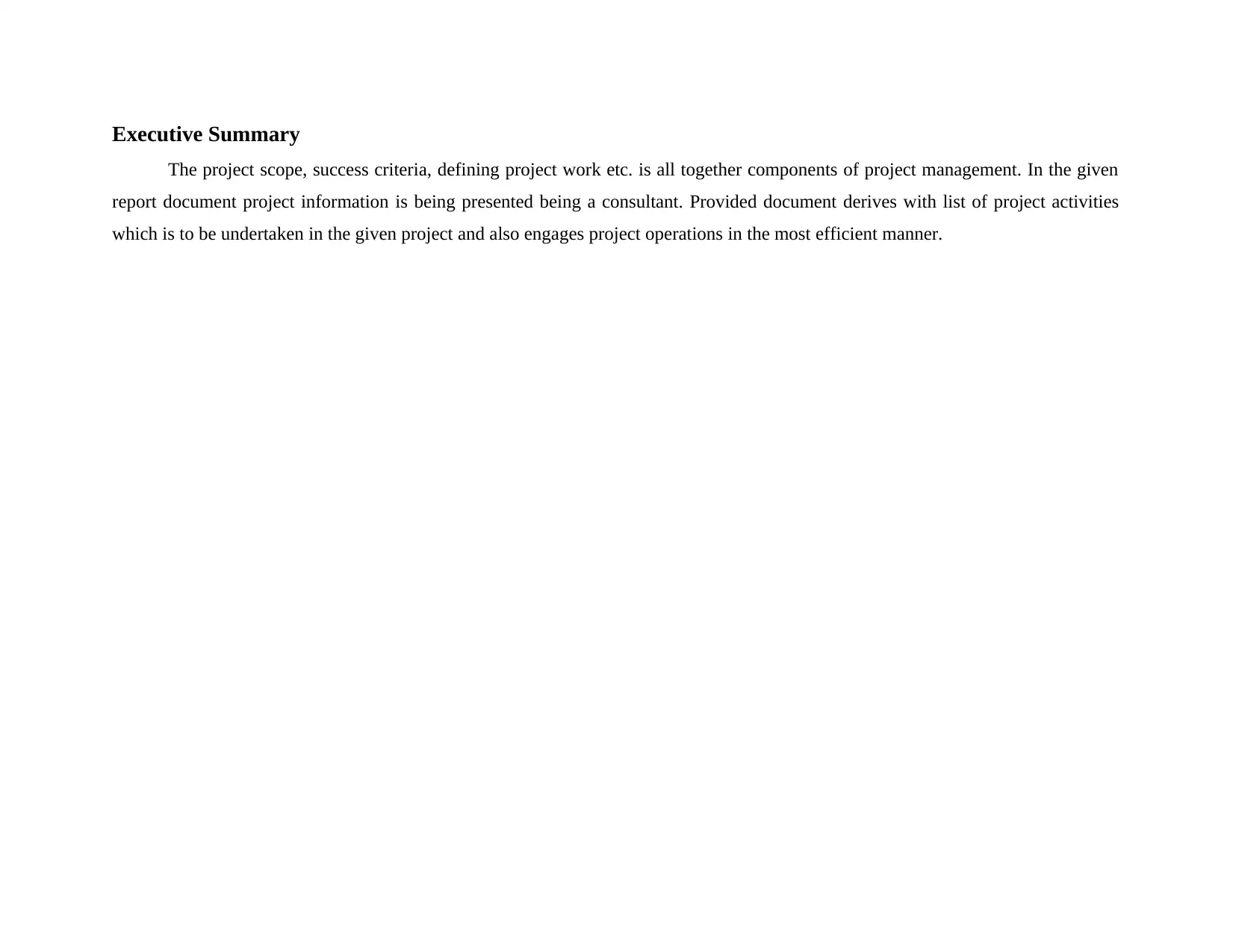
Executive Summary
The project scope, success criteria, defining project work etc. is all together components of project management. In the given
report document project information is being presented being a consultant. Provided document derives with list of project activities
which is to be undertaken in the given project and also engages project operations in the most efficient manner.
The project scope, success criteria, defining project work etc. is all together components of project management. In the given
report document project information is being presented being a consultant. Provided document derives with list of project activities
which is to be undertaken in the given project and also engages project operations in the most efficient manner.
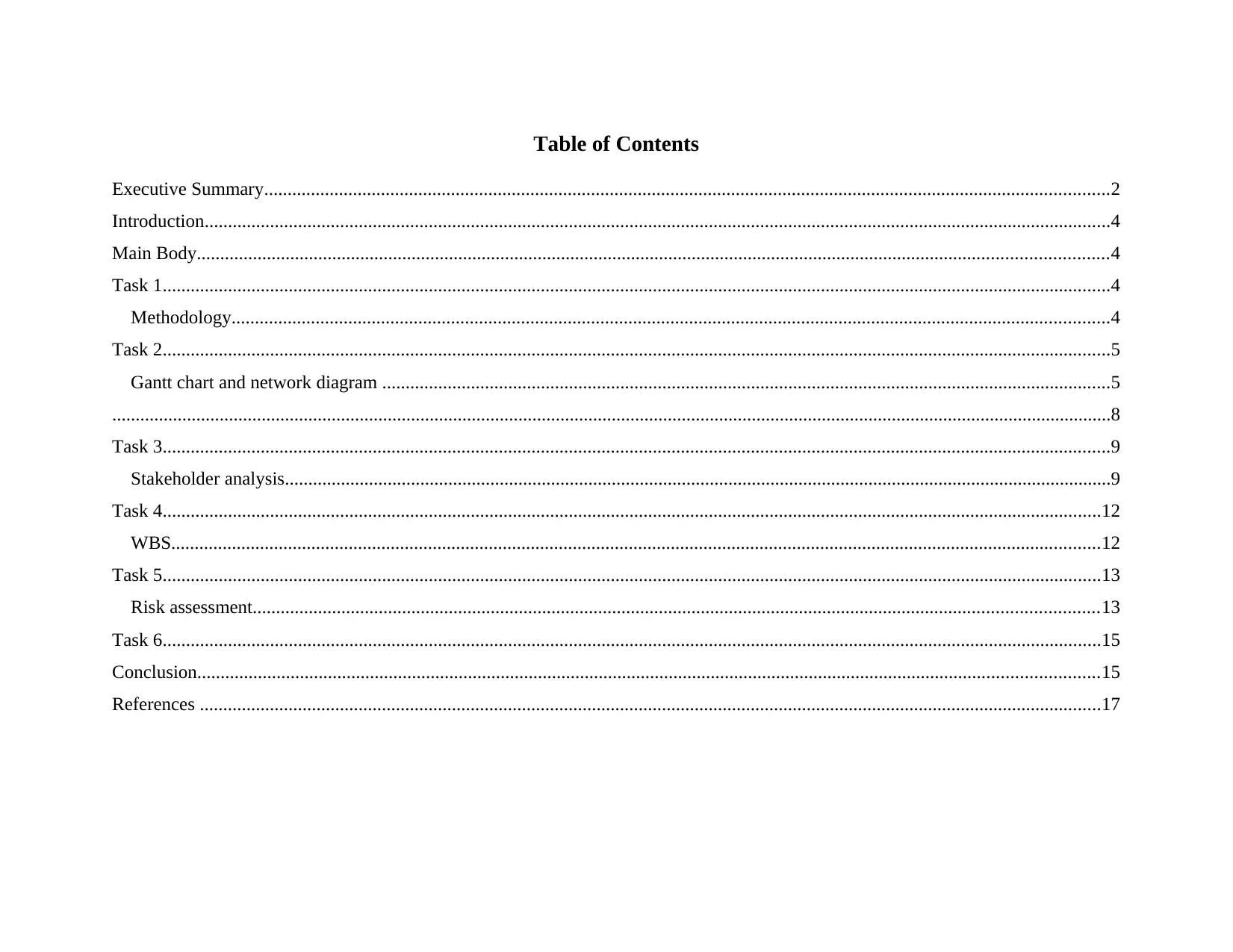
Table of Contents
Executive Summary.....................................................................................................................................................................................2
Introduction..................................................................................................................................................................................................4
Main Body...................................................................................................................................................................................................4
Task 1...........................................................................................................................................................................................................4
Methodology............................................................................................................................................................................................4
Task 2...........................................................................................................................................................................................................5
Gantt chart and network diagram ............................................................................................................................................................5
......................................................................................................................................................................................................................8
Task 3...........................................................................................................................................................................................................9
Stakeholder analysis.................................................................................................................................................................................9
Task 4.........................................................................................................................................................................................................12
WBS.......................................................................................................................................................................................................12
Task 5.........................................................................................................................................................................................................13
Risk assessment.....................................................................................................................................................................................13
Task 6.........................................................................................................................................................................................................15
Conclusion.................................................................................................................................................................................................15
References .................................................................................................................................................................................................17
Executive Summary.....................................................................................................................................................................................2
Introduction..................................................................................................................................................................................................4
Main Body...................................................................................................................................................................................................4
Task 1...........................................................................................................................................................................................................4
Methodology............................................................................................................................................................................................4
Task 2...........................................................................................................................................................................................................5
Gantt chart and network diagram ............................................................................................................................................................5
......................................................................................................................................................................................................................8
Task 3...........................................................................................................................................................................................................9
Stakeholder analysis.................................................................................................................................................................................9
Task 4.........................................................................................................................................................................................................12
WBS.......................................................................................................................................................................................................12
Task 5.........................................................................................................................................................................................................13
Risk assessment.....................................................................................................................................................................................13
Task 6.........................................................................................................................................................................................................15
Conclusion.................................................................................................................................................................................................15
References .................................................................................................................................................................................................17
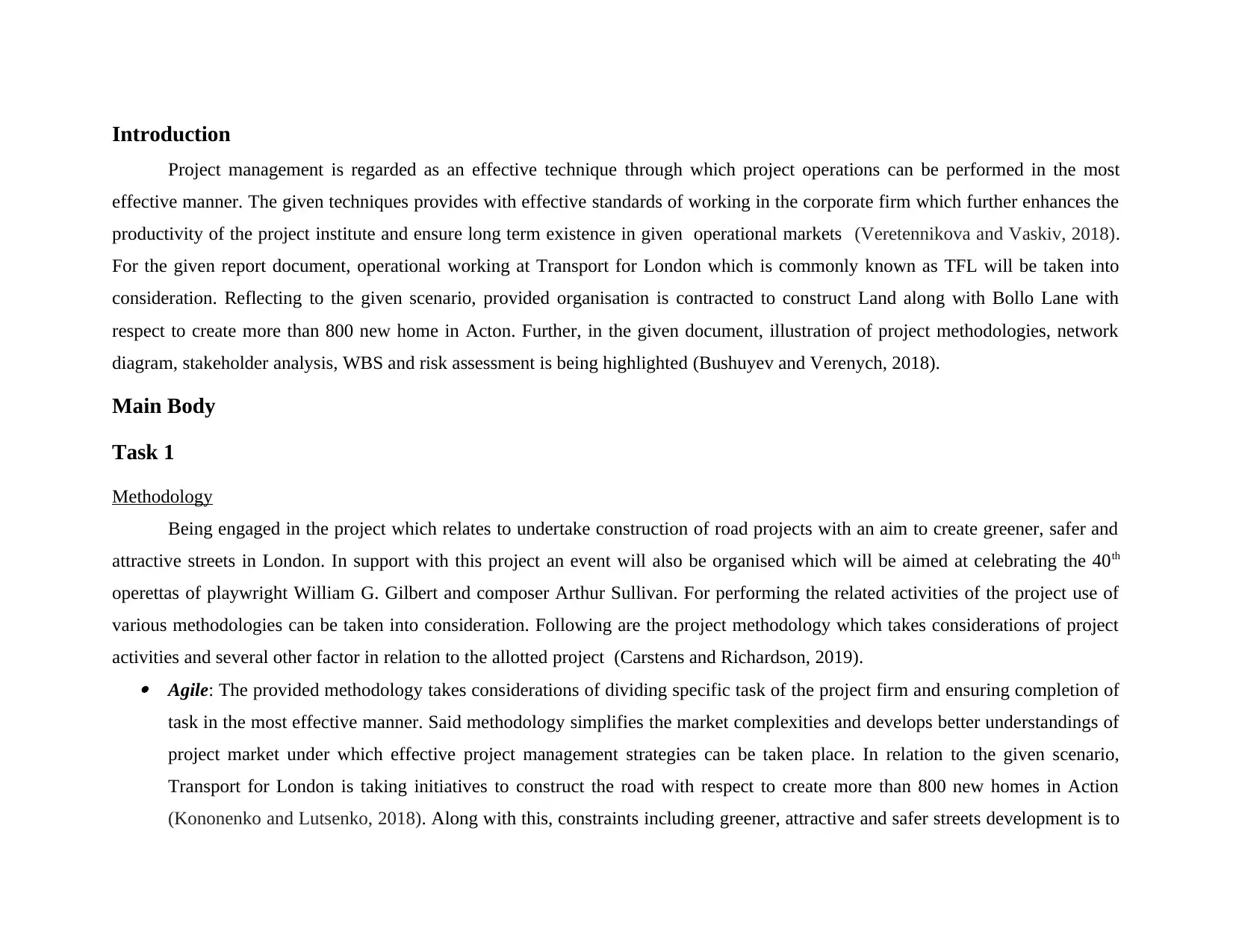
Introduction
Project management is regarded as an effective technique through which project operations can be performed in the most
effective manner. The given techniques provides with effective standards of working in the corporate firm which further enhances the
productivity of the project institute and ensure long term existence in given operational markets (Veretennikova and Vaskiv, 2018).
For the given report document, operational working at Transport for London which is commonly known as TFL will be taken into
consideration. Reflecting to the given scenario, provided organisation is contracted to construct Land along with Bollo Lane with
respect to create more than 800 new home in Acton. Further, in the given document, illustration of project methodologies, network
diagram, stakeholder analysis, WBS and risk assessment is being highlighted (Bushuyev and Verenych, 2018).
Main Body
Task 1
Methodology
Being engaged in the project which relates to undertake construction of road projects with an aim to create greener, safer and
attractive streets in London. In support with this project an event will also be organised which will be aimed at celebrating the 40th
operettas of playwright William G. Gilbert and composer Arthur Sullivan. For performing the related activities of the project use of
various methodologies can be taken into consideration. Following are the project methodology which takes considerations of project
activities and several other factor in relation to the allotted project (Carstens and Richardson, 2019). Agile: The provided methodology takes considerations of dividing specific task of the project firm and ensuring completion of
task in the most effective manner. Said methodology simplifies the market complexities and develops better understandings of
project market under which effective project management strategies can be taken place. In relation to the given scenario,
Transport for London is taking initiatives to construct the road with respect to create more than 800 new homes in Action
(Kononenko and Lutsenko, 2018). Along with this, constraints including greener, attractive and safer streets development is to
Project management is regarded as an effective technique through which project operations can be performed in the most
effective manner. The given techniques provides with effective standards of working in the corporate firm which further enhances the
productivity of the project institute and ensure long term existence in given operational markets (Veretennikova and Vaskiv, 2018).
For the given report document, operational working at Transport for London which is commonly known as TFL will be taken into
consideration. Reflecting to the given scenario, provided organisation is contracted to construct Land along with Bollo Lane with
respect to create more than 800 new home in Acton. Further, in the given document, illustration of project methodologies, network
diagram, stakeholder analysis, WBS and risk assessment is being highlighted (Bushuyev and Verenych, 2018).
Main Body
Task 1
Methodology
Being engaged in the project which relates to undertake construction of road projects with an aim to create greener, safer and
attractive streets in London. In support with this project an event will also be organised which will be aimed at celebrating the 40th
operettas of playwright William G. Gilbert and composer Arthur Sullivan. For performing the related activities of the project use of
various methodologies can be taken into consideration. Following are the project methodology which takes considerations of project
activities and several other factor in relation to the allotted project (Carstens and Richardson, 2019). Agile: The provided methodology takes considerations of dividing specific task of the project firm and ensuring completion of
task in the most effective manner. Said methodology simplifies the market complexities and develops better understandings of
project market under which effective project management strategies can be taken place. In relation to the given scenario,
Transport for London is taking initiatives to construct the road with respect to create more than 800 new homes in Action
(Kononenko and Lutsenko, 2018). Along with this, constraints including greener, attractive and safer streets development is to
Secure Best Marks with AI Grader
Need help grading? Try our AI Grader for instant feedback on your assignments.
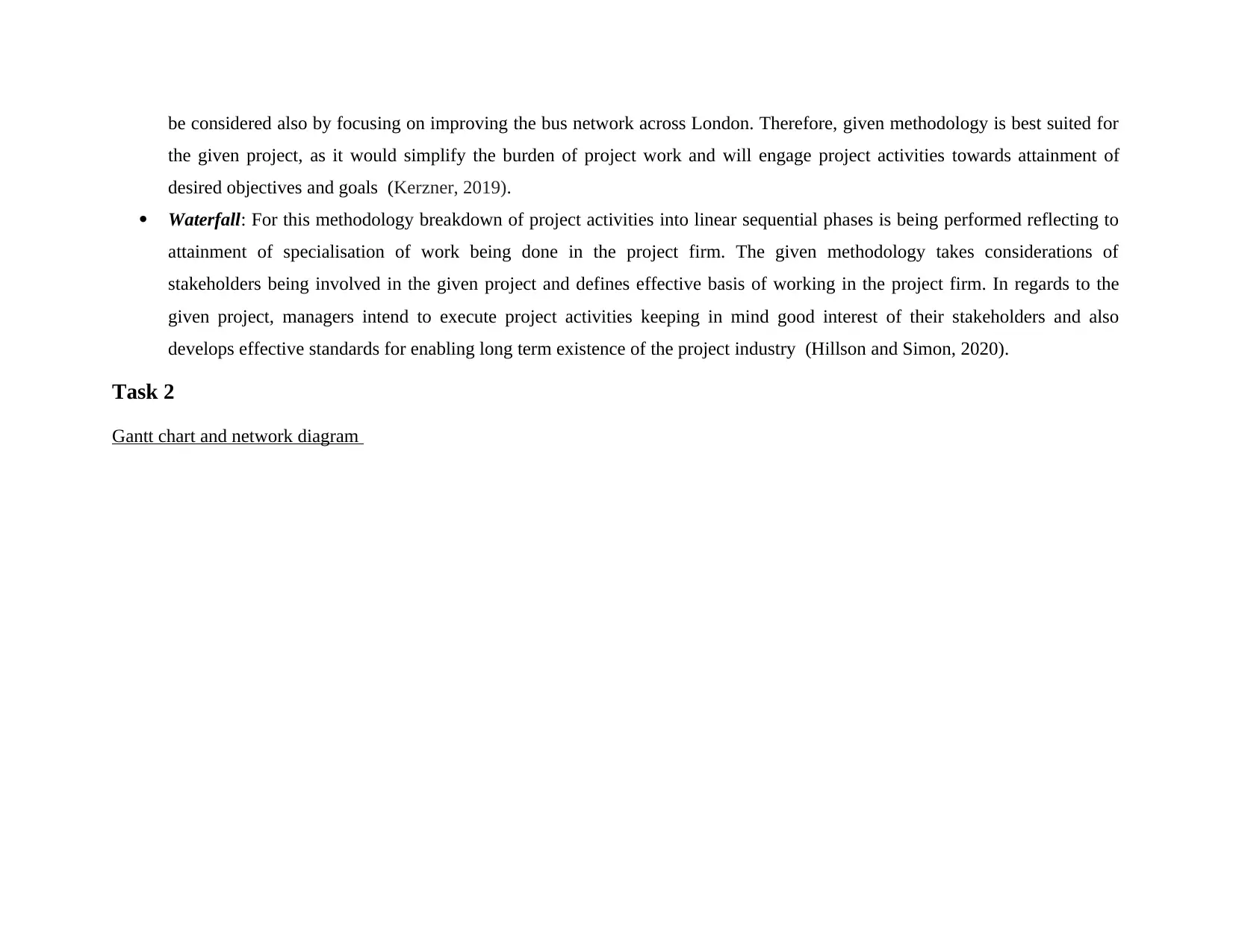
be considered also by focusing on improving the bus network across London. Therefore, given methodology is best suited for
the given project, as it would simplify the burden of project work and will engage project activities towards attainment of
desired objectives and goals (Kerzner, 2019).
Waterfall: For this methodology breakdown of project activities into linear sequential phases is being performed reflecting to
attainment of specialisation of work being done in the project firm. The given methodology takes considerations of
stakeholders being involved in the given project and defines effective basis of working in the project firm. In regards to the
given project, managers intend to execute project activities keeping in mind good interest of their stakeholders and also
develops effective standards for enabling long term existence of the project industry (Hillson and Simon, 2020).
Task 2
Gantt chart and network diagram
the given project, as it would simplify the burden of project work and will engage project activities towards attainment of
desired objectives and goals (Kerzner, 2019).
Waterfall: For this methodology breakdown of project activities into linear sequential phases is being performed reflecting to
attainment of specialisation of work being done in the project firm. The given methodology takes considerations of
stakeholders being involved in the given project and defines effective basis of working in the project firm. In regards to the
given project, managers intend to execute project activities keeping in mind good interest of their stakeholders and also
develops effective standards for enabling long term existence of the project industry (Hillson and Simon, 2020).
Task 2
Gantt chart and network diagram
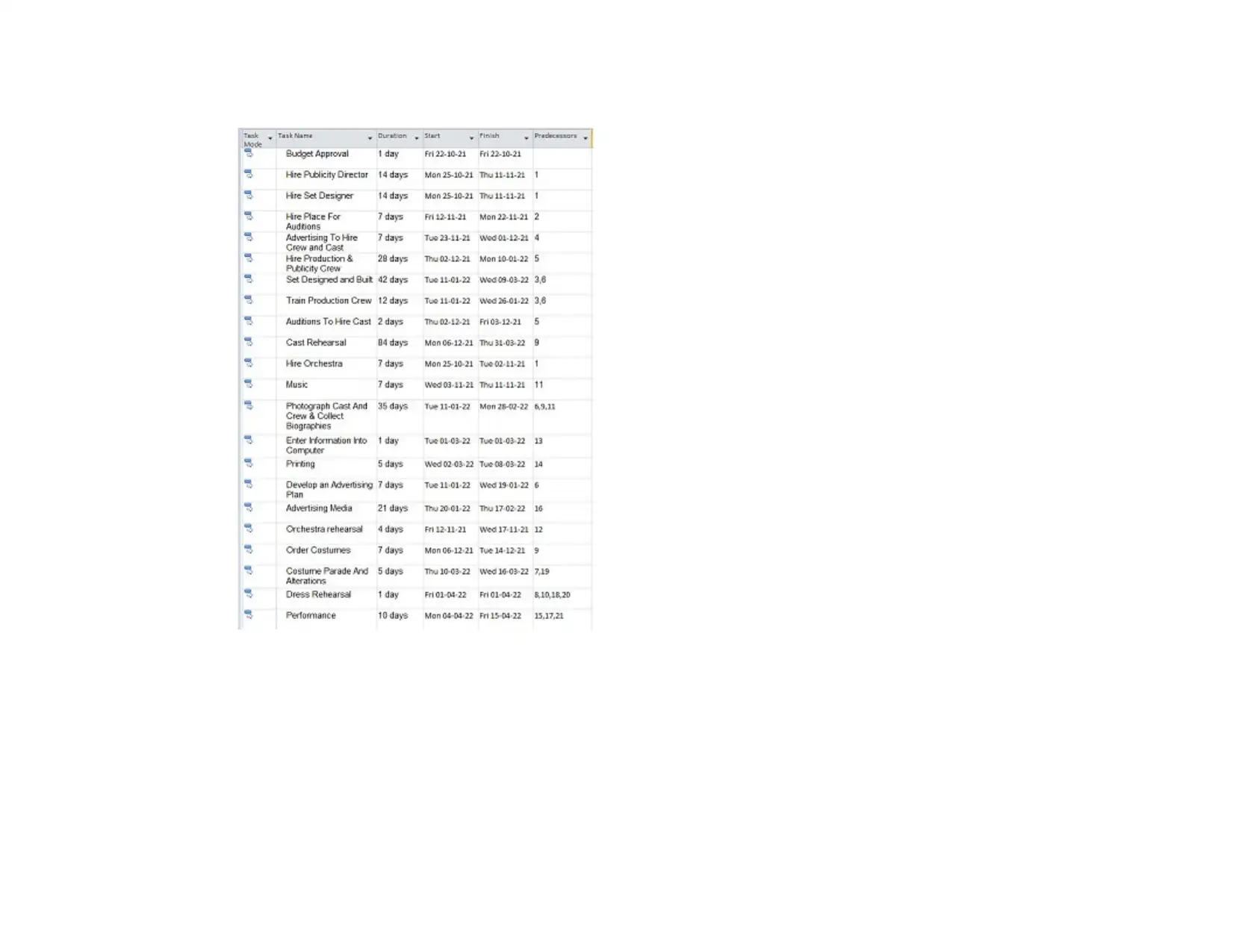
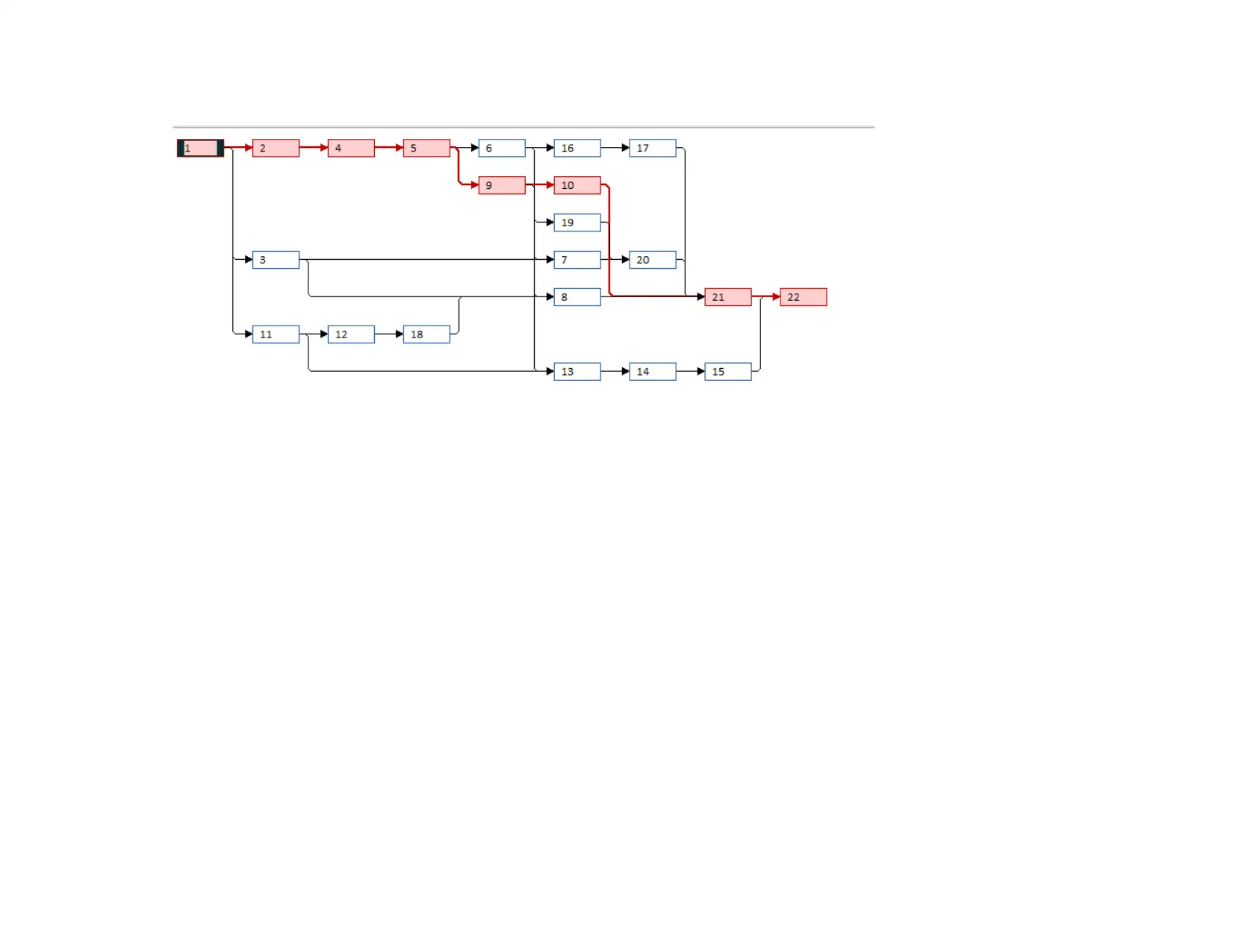
Paraphrase This Document
Need a fresh take? Get an instant paraphrase of this document with our AI Paraphraser
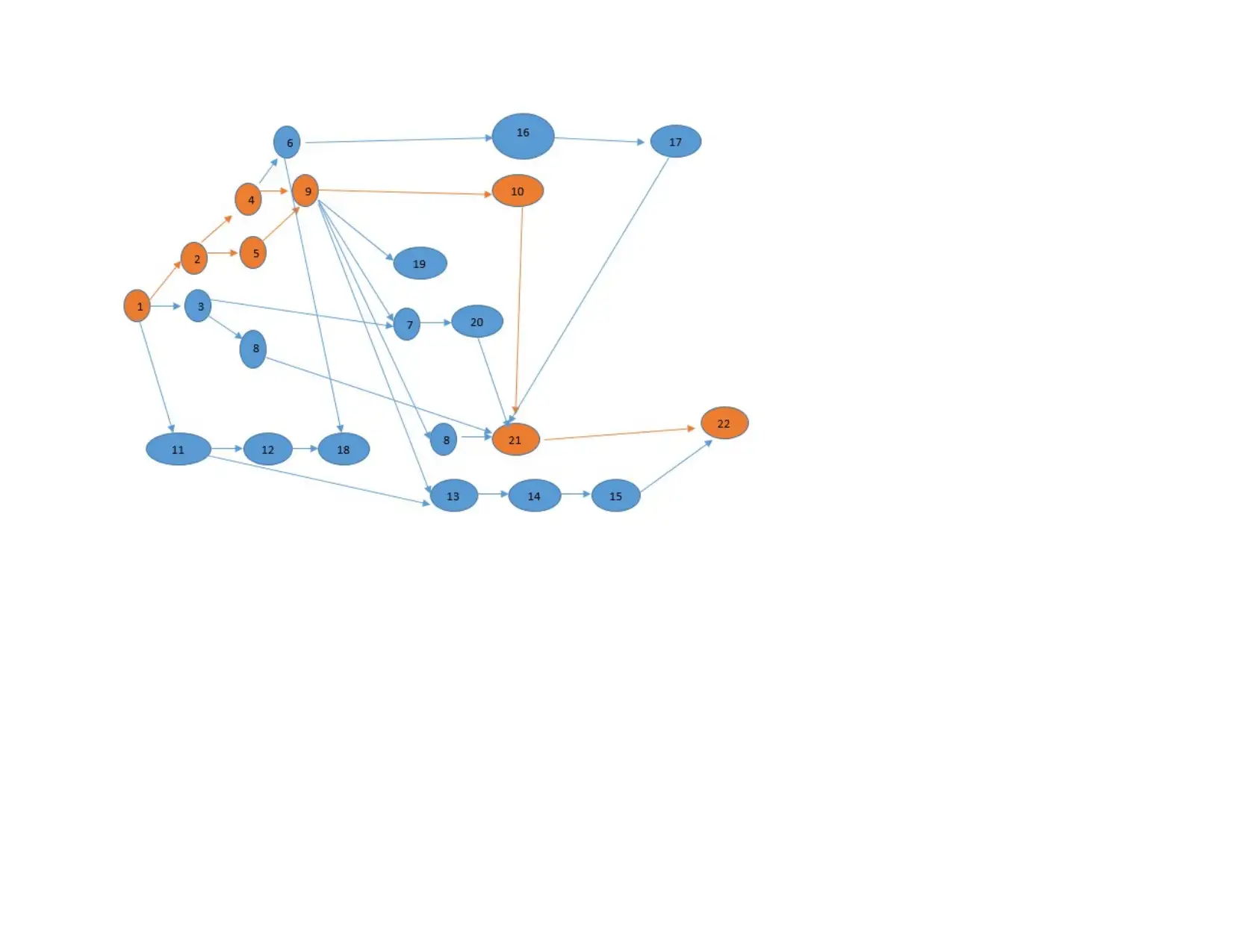
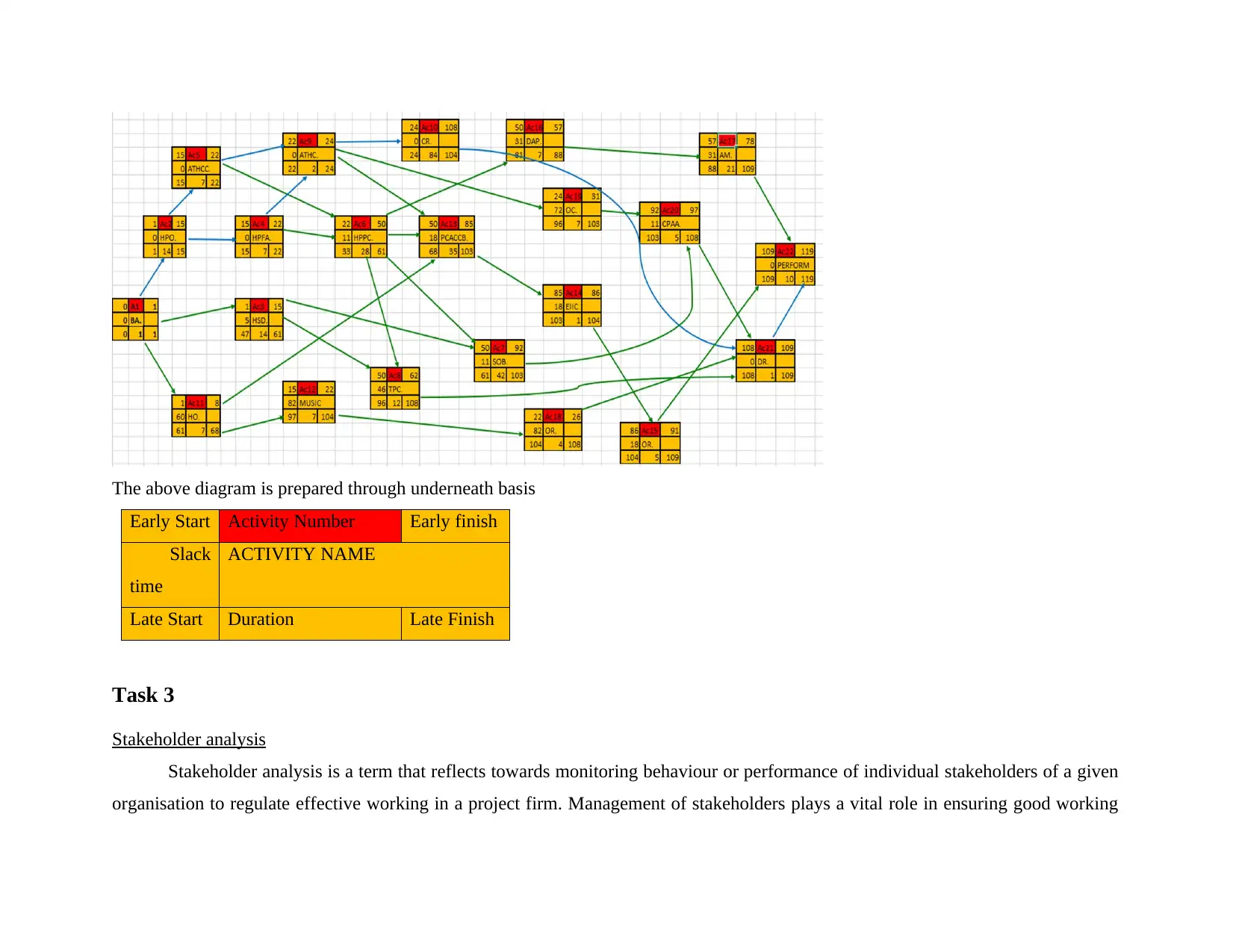
The above diagram is prepared through underneath basis
Early Start Activity Number Early finish
Slack
time
ACTIVITY NAME
Late Start Duration Late Finish
Task 3
Stakeholder analysis
Stakeholder analysis is a term that reflects towards monitoring behaviour or performance of individual stakeholders of a given
organisation to regulate effective working in a project firm. Management of stakeholders plays a vital role in ensuring good working
Early Start Activity Number Early finish
Slack
time
ACTIVITY NAME
Late Start Duration Late Finish
Task 3
Stakeholder analysis
Stakeholder analysis is a term that reflects towards monitoring behaviour or performance of individual stakeholders of a given
organisation to regulate effective working in a project firm. Management of stakeholders plays a vital role in ensuring good working
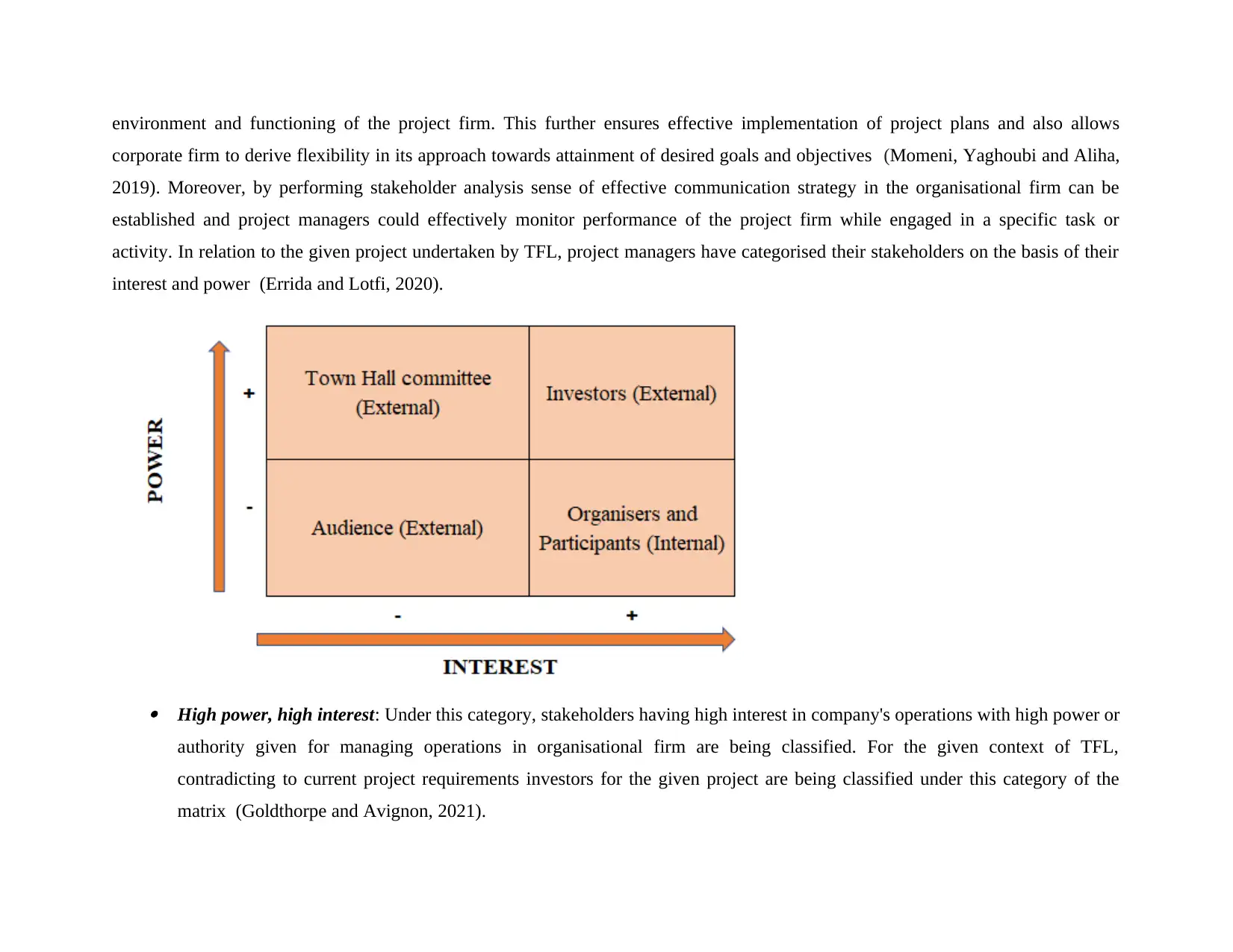
environment and functioning of the project firm. This further ensures effective implementation of project plans and also allows
corporate firm to derive flexibility in its approach towards attainment of desired goals and objectives (Momeni, Yaghoubi and Aliha,
2019). Moreover, by performing stakeholder analysis sense of effective communication strategy in the organisational firm can be
established and project managers could effectively monitor performance of the project firm while engaged in a specific task or
activity. In relation to the given project undertaken by TFL, project managers have categorised their stakeholders on the basis of their
interest and power (Errida and Lotfi, 2020).
High power, high interest: Under this category, stakeholders having high interest in company's operations with high power or
authority given for managing operations in organisational firm are being classified. For the given context of TFL,
contradicting to current project requirements investors for the given project are being classified under this category of the
matrix (Goldthorpe and Avignon, 2021).
corporate firm to derive flexibility in its approach towards attainment of desired goals and objectives (Momeni, Yaghoubi and Aliha,
2019). Moreover, by performing stakeholder analysis sense of effective communication strategy in the organisational firm can be
established and project managers could effectively monitor performance of the project firm while engaged in a specific task or
activity. In relation to the given project undertaken by TFL, project managers have categorised their stakeholders on the basis of their
interest and power (Errida and Lotfi, 2020).
High power, high interest: Under this category, stakeholders having high interest in company's operations with high power or
authority given for managing operations in organisational firm are being classified. For the given context of TFL,
contradicting to current project requirements investors for the given project are being classified under this category of the
matrix (Goldthorpe and Avignon, 2021).
Secure Best Marks with AI Grader
Need help grading? Try our AI Grader for instant feedback on your assignments.
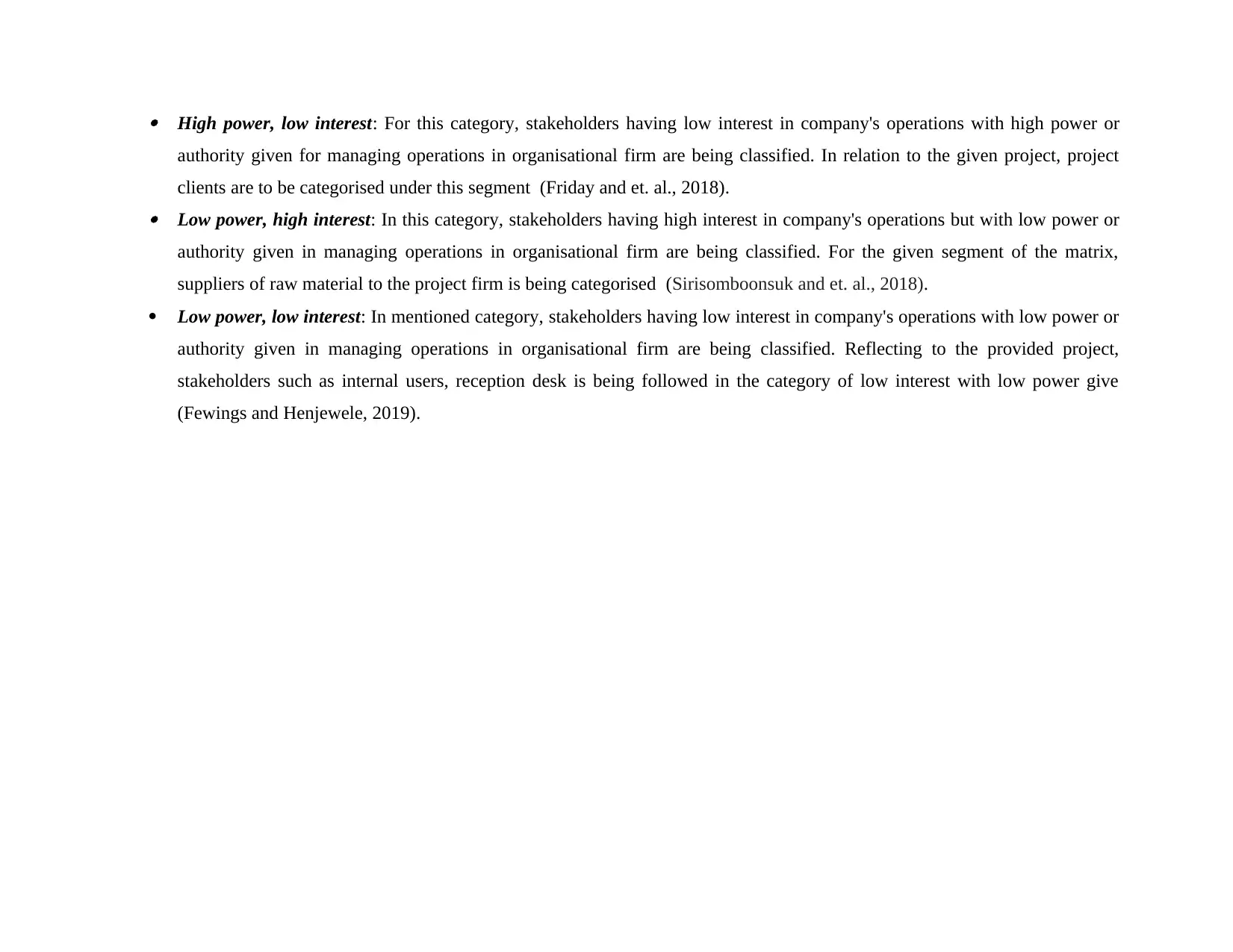
High power, low interest: For this category, stakeholders having low interest in company's operations with high power or
authority given for managing operations in organisational firm are being classified. In relation to the given project, project
clients are to be categorised under this segment (Friday and et. al., 2018). Low power, high interest: In this category, stakeholders having high interest in company's operations but with low power or
authority given in managing operations in organisational firm are being classified. For the given segment of the matrix,
suppliers of raw material to the project firm is being categorised (Sirisomboonsuk and et. al., 2018).
Low power, low interest: In mentioned category, stakeholders having low interest in company's operations with low power or
authority given in managing operations in organisational firm are being classified. Reflecting to the provided project,
stakeholders such as internal users, reception desk is being followed in the category of low interest with low power give
(Fewings and Henjewele, 2019).
authority given for managing operations in organisational firm are being classified. In relation to the given project, project
clients are to be categorised under this segment (Friday and et. al., 2018). Low power, high interest: In this category, stakeholders having high interest in company's operations but with low power or
authority given in managing operations in organisational firm are being classified. For the given segment of the matrix,
suppliers of raw material to the project firm is being categorised (Sirisomboonsuk and et. al., 2018).
Low power, low interest: In mentioned category, stakeholders having low interest in company's operations with low power or
authority given in managing operations in organisational firm are being classified. Reflecting to the provided project,
stakeholders such as internal users, reception desk is being followed in the category of low interest with low power give
(Fewings and Henjewele, 2019).
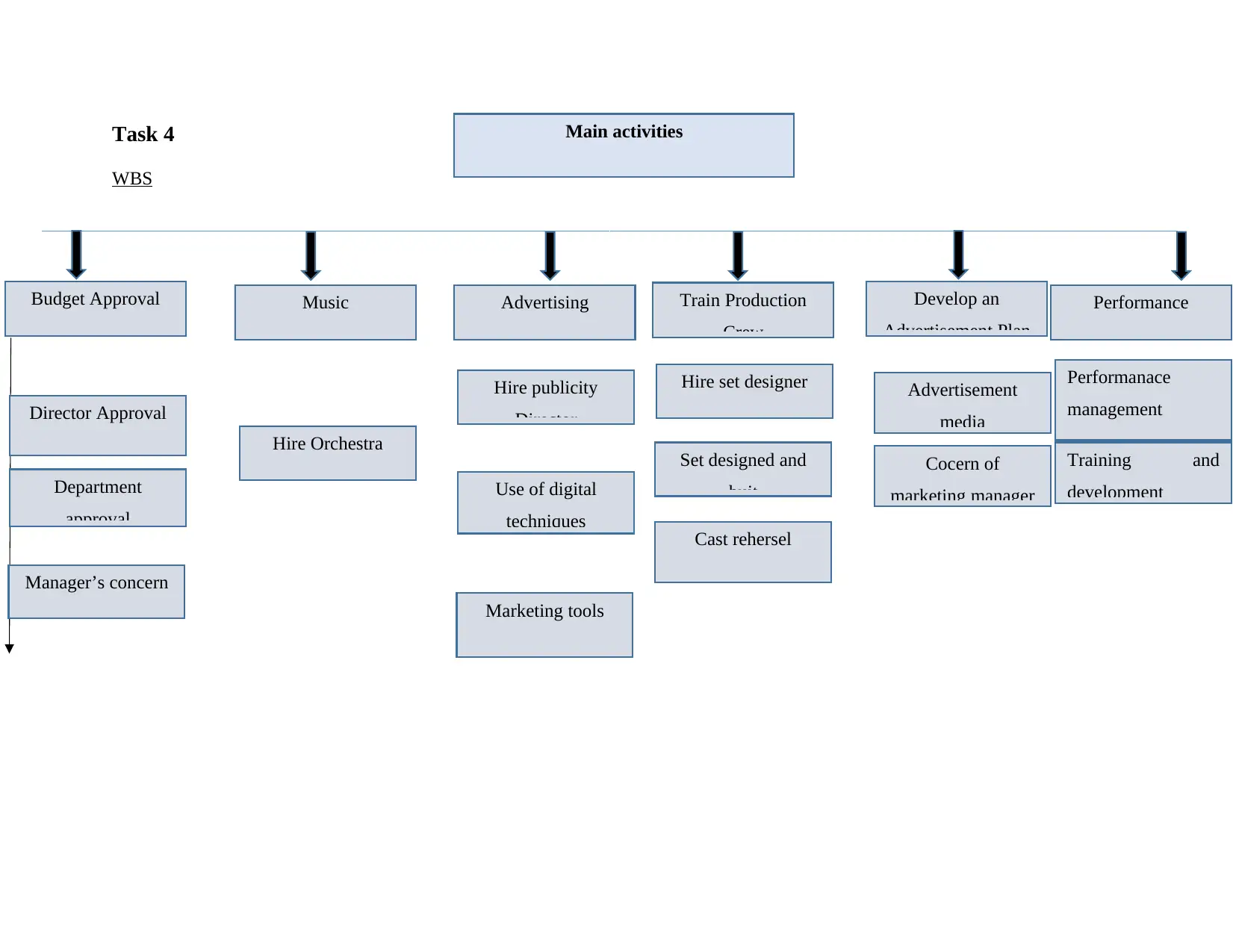
Task 4
WBS
Budget Approval Music Advertising Develop an
Advertisement Plan
Train Production
Crew
Performance
Director Approval
Department
approval
Hire Orchestra
Manager’s concern
Hire publicity
Director
Use of digital
techniques
Marketing tools
Hire set designer
Set designed and
buit
Cast rehersel
Advertisement
media
Cocern of
marketing manager
Performanace
management
techniques
Training and
development
Main activities
WBS
Budget Approval Music Advertising Develop an
Advertisement Plan
Train Production
Crew
Performance
Director Approval
Department
approval
Hire Orchestra
Manager’s concern
Hire publicity
Director
Use of digital
techniques
Marketing tools
Hire set designer
Set designed and
buit
Cast rehersel
Advertisement
media
Cocern of
marketing manager
Performanace
management
techniques
Training and
development
Main activities
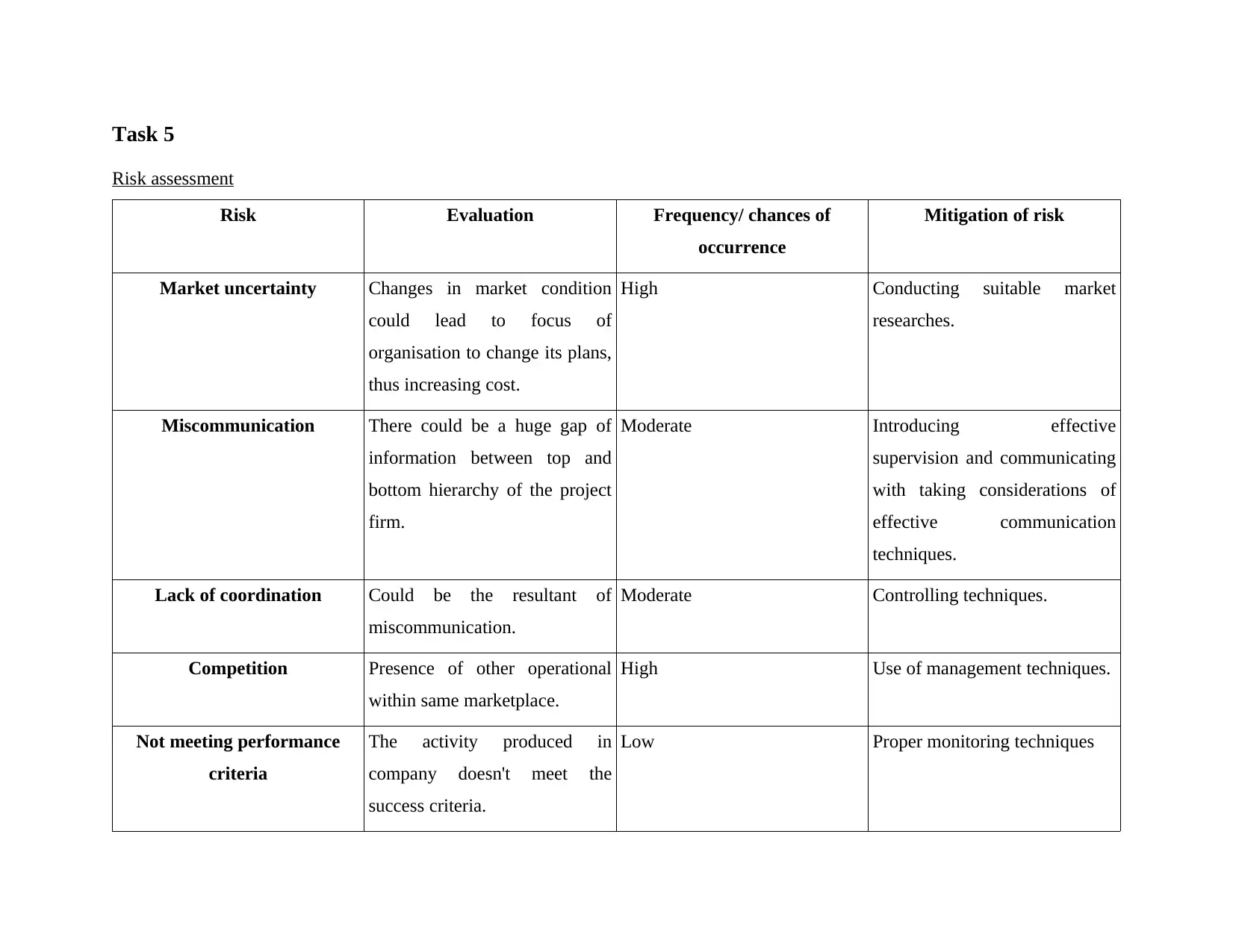
Task 5
Risk assessment
Risk Evaluation Frequency/ chances of
occurrence
Mitigation of risk
Market uncertainty Changes in market condition
could lead to focus of
organisation to change its plans,
thus increasing cost.
High Conducting suitable market
researches.
Miscommunication There could be a huge gap of
information between top and
bottom hierarchy of the project
firm.
Moderate Introducing effective
supervision and communicating
with taking considerations of
effective communication
techniques.
Lack of coordination Could be the resultant of
miscommunication.
Moderate Controlling techniques.
Competition Presence of other operational
within same marketplace.
High Use of management techniques.
Not meeting performance
criteria
The activity produced in
company doesn't meet the
success criteria.
Low Proper monitoring techniques
Risk assessment
Risk Evaluation Frequency/ chances of
occurrence
Mitigation of risk
Market uncertainty Changes in market condition
could lead to focus of
organisation to change its plans,
thus increasing cost.
High Conducting suitable market
researches.
Miscommunication There could be a huge gap of
information between top and
bottom hierarchy of the project
firm.
Moderate Introducing effective
supervision and communicating
with taking considerations of
effective communication
techniques.
Lack of coordination Could be the resultant of
miscommunication.
Moderate Controlling techniques.
Competition Presence of other operational
within same marketplace.
High Use of management techniques.
Not meeting performance
criteria
The activity produced in
company doesn't meet the
success criteria.
Low Proper monitoring techniques
Paraphrase This Document
Need a fresh take? Get an instant paraphrase of this document with our AI Paraphraser
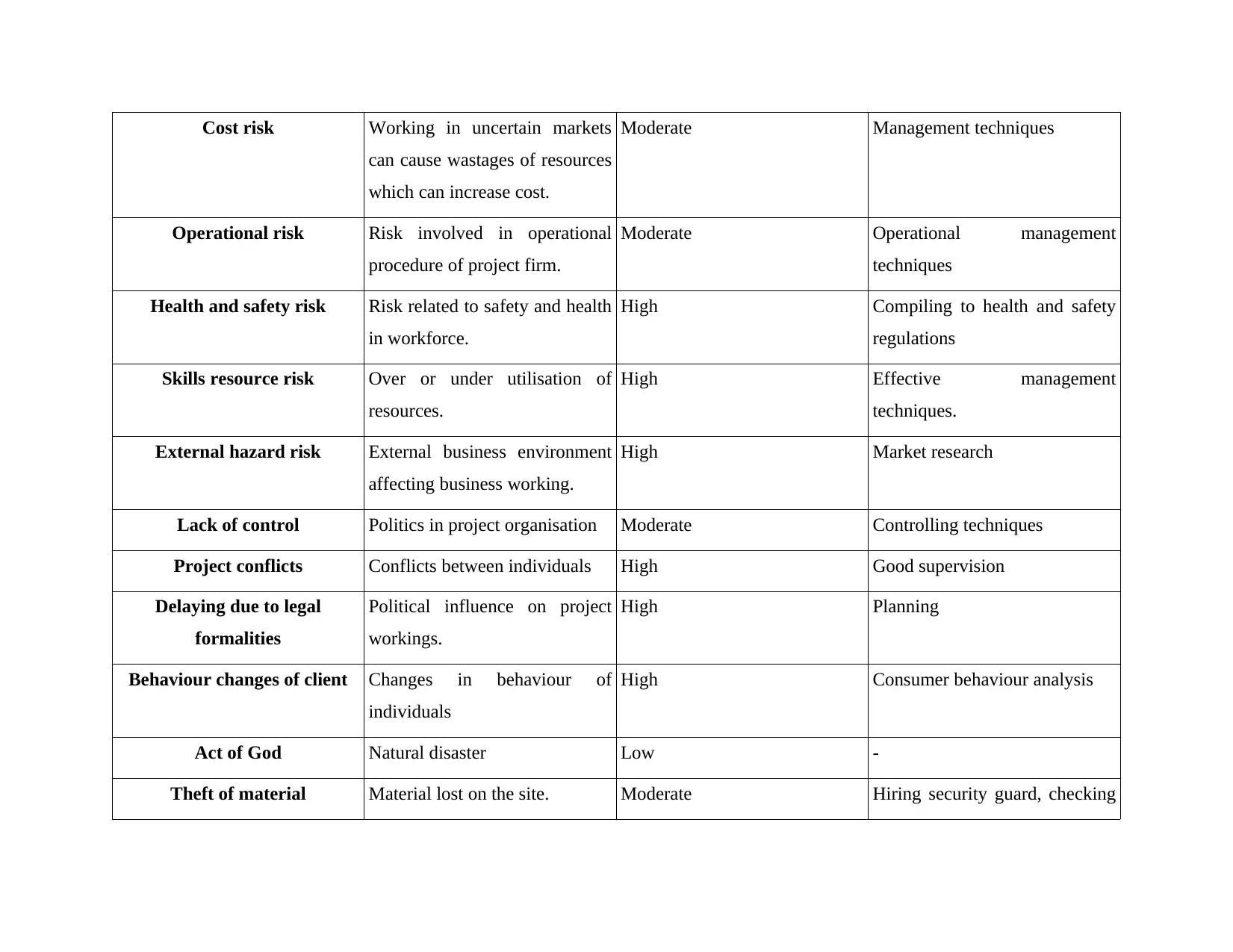
Cost risk Working in uncertain markets
can cause wastages of resources
which can increase cost.
Moderate Management techniques
Operational risk Risk involved in operational
procedure of project firm.
Moderate Operational management
techniques
Health and safety risk Risk related to safety and health
in workforce.
High Compiling to health and safety
regulations
Skills resource risk Over or under utilisation of
resources.
High Effective management
techniques.
External hazard risk External business environment
affecting business working.
High Market research
Lack of control Politics in project organisation Moderate Controlling techniques
Project conflicts Conflicts between individuals High Good supervision
Delaying due to legal
formalities
Political influence on project
workings.
High Planning
Behaviour changes of client Changes in behaviour of
individuals
High Consumer behaviour analysis
Act of God Natural disaster Low -
Theft of material Material lost on the site. Moderate Hiring security guard, checking
can cause wastages of resources
which can increase cost.
Moderate Management techniques
Operational risk Risk involved in operational
procedure of project firm.
Moderate Operational management
techniques
Health and safety risk Risk related to safety and health
in workforce.
High Compiling to health and safety
regulations
Skills resource risk Over or under utilisation of
resources.
High Effective management
techniques.
External hazard risk External business environment
affecting business working.
High Market research
Lack of control Politics in project organisation Moderate Controlling techniques
Project conflicts Conflicts between individuals High Good supervision
Delaying due to legal
formalities
Political influence on project
workings.
High Planning
Behaviour changes of client Changes in behaviour of
individuals
High Consumer behaviour analysis
Act of God Natural disaster Low -
Theft of material Material lost on the site. Moderate Hiring security guard, checking
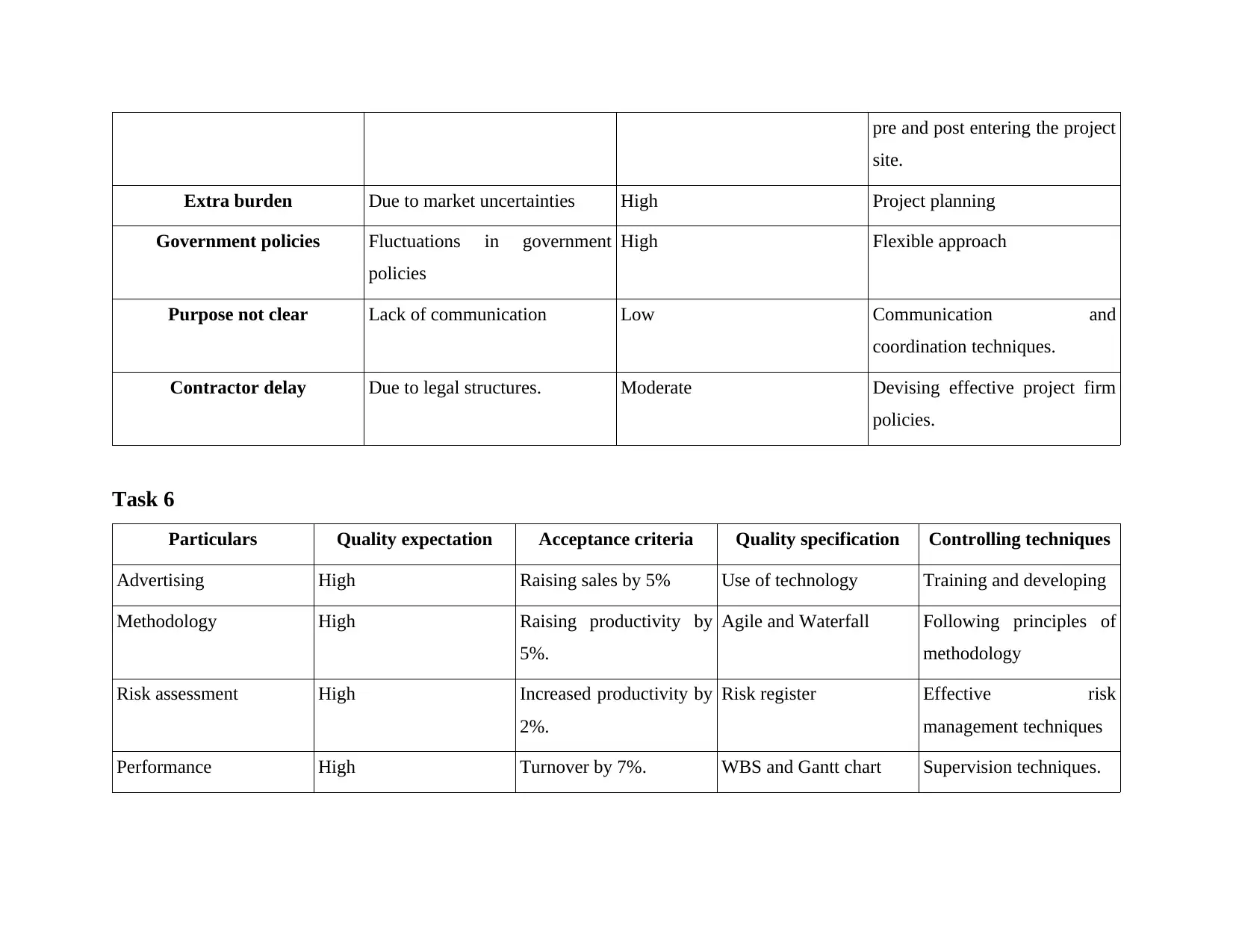
pre and post entering the project
site.
Extra burden Due to market uncertainties High Project planning
Government policies Fluctuations in government
policies
High Flexible approach
Purpose not clear Lack of communication Low Communication and
coordination techniques.
Contractor delay Due to legal structures. Moderate Devising effective project firm
policies.
Task 6
Particulars Quality expectation Acceptance criteria Quality specification Controlling techniques
Advertising High Raising sales by 5% Use of technology Training and developing
Methodology High Raising productivity by
5%.
Agile and Waterfall Following principles of
methodology
Risk assessment High Increased productivity by
2%.
Risk register Effective risk
management techniques
Performance High Turnover by 7%. WBS and Gantt chart Supervision techniques.
site.
Extra burden Due to market uncertainties High Project planning
Government policies Fluctuations in government
policies
High Flexible approach
Purpose not clear Lack of communication Low Communication and
coordination techniques.
Contractor delay Due to legal structures. Moderate Devising effective project firm
policies.
Task 6
Particulars Quality expectation Acceptance criteria Quality specification Controlling techniques
Advertising High Raising sales by 5% Use of technology Training and developing
Methodology High Raising productivity by
5%.
Agile and Waterfall Following principles of
methodology
Risk assessment High Increased productivity by
2%.
Risk register Effective risk
management techniques
Performance High Turnover by 7%. WBS and Gantt chart Supervision techniques.
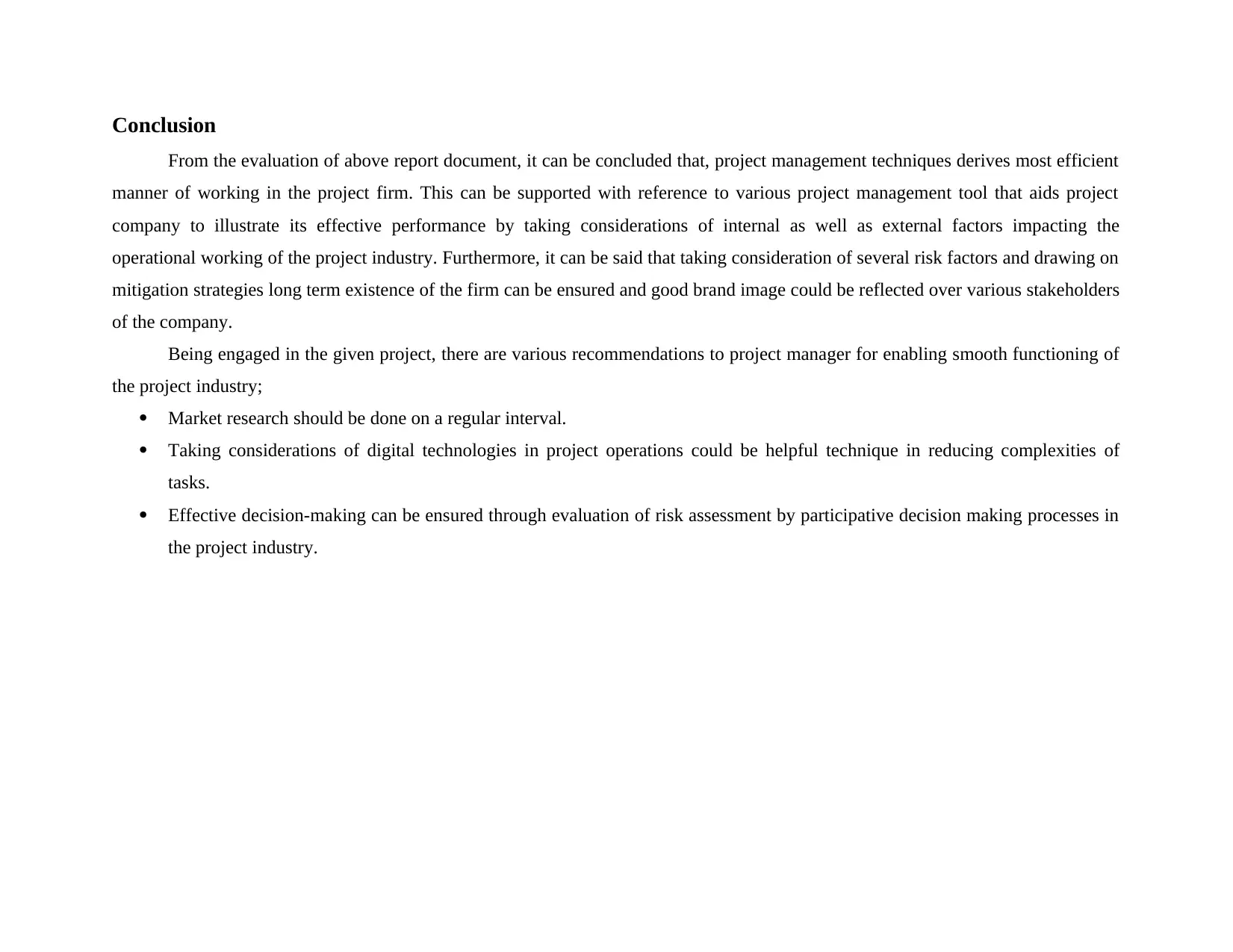
Conclusion
From the evaluation of above report document, it can be concluded that, project management techniques derives most efficient
manner of working in the project firm. This can be supported with reference to various project management tool that aids project
company to illustrate its effective performance by taking considerations of internal as well as external factors impacting the
operational working of the project industry. Furthermore, it can be said that taking consideration of several risk factors and drawing on
mitigation strategies long term existence of the firm can be ensured and good brand image could be reflected over various stakeholders
of the company.
Being engaged in the given project, there are various recommendations to project manager for enabling smooth functioning of
the project industry;
Market research should be done on a regular interval.
Taking considerations of digital technologies in project operations could be helpful technique in reducing complexities of
tasks.
Effective decision-making can be ensured through evaluation of risk assessment by participative decision making processes in
the project industry.
From the evaluation of above report document, it can be concluded that, project management techniques derives most efficient
manner of working in the project firm. This can be supported with reference to various project management tool that aids project
company to illustrate its effective performance by taking considerations of internal as well as external factors impacting the
operational working of the project industry. Furthermore, it can be said that taking consideration of several risk factors and drawing on
mitigation strategies long term existence of the firm can be ensured and good brand image could be reflected over various stakeholders
of the company.
Being engaged in the given project, there are various recommendations to project manager for enabling smooth functioning of
the project industry;
Market research should be done on a regular interval.
Taking considerations of digital technologies in project operations could be helpful technique in reducing complexities of
tasks.
Effective decision-making can be ensured through evaluation of risk assessment by participative decision making processes in
the project industry.
Secure Best Marks with AI Grader
Need help grading? Try our AI Grader for instant feedback on your assignments.
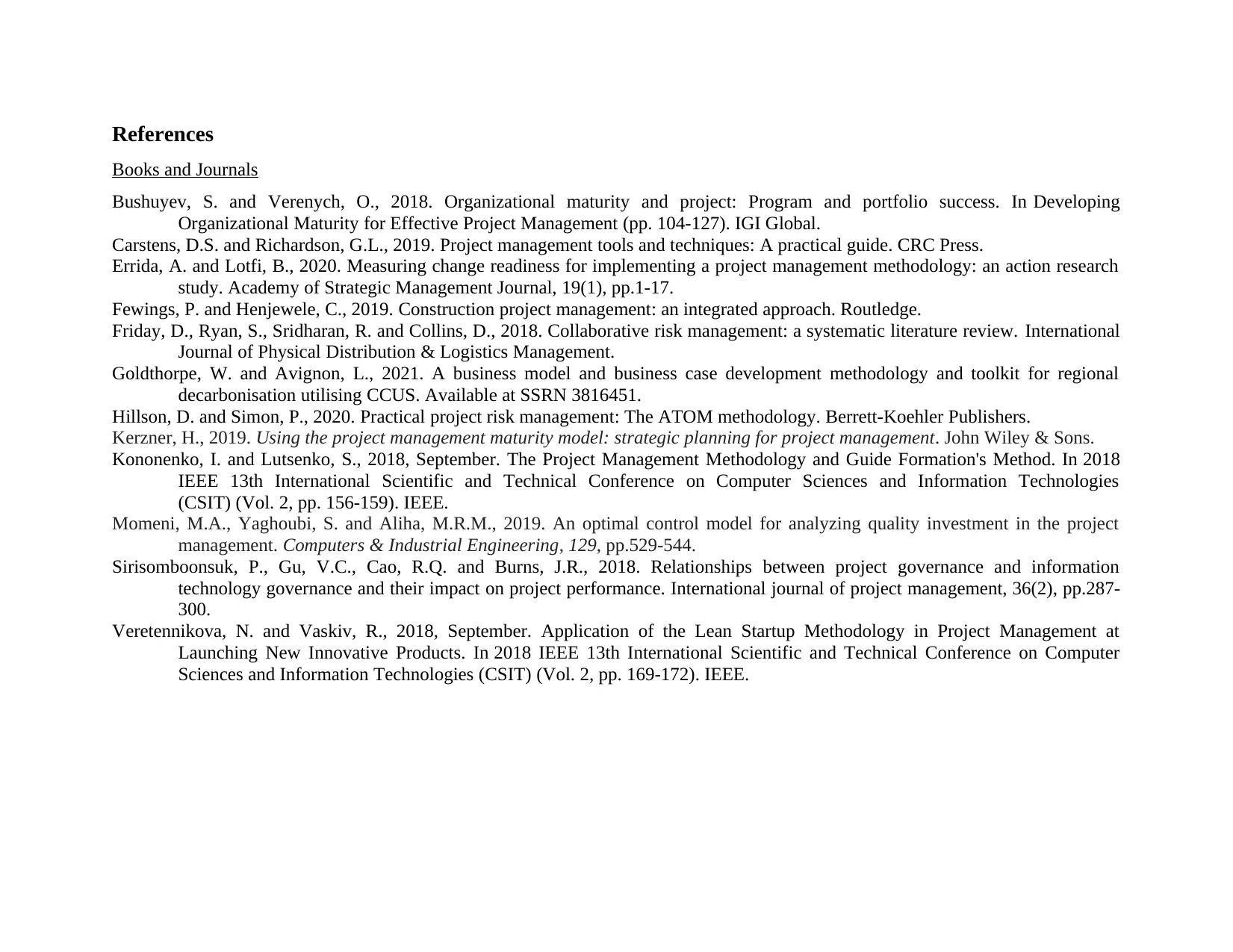
References
Books and Journals
Bushuyev, S. and Verenych, O., 2018. Organizational maturity and project: Program and portfolio success. In Developing
Organizational Maturity for Effective Project Management (pp. 104-127). IGI Global.
Carstens, D.S. and Richardson, G.L., 2019. Project management tools and techniques: A practical guide. CRC Press.
Errida, A. and Lotfi, B., 2020. Measuring change readiness for implementing a project management methodology: an action research
study. Academy of Strategic Management Journal, 19(1), pp.1-17.
Fewings, P. and Henjewele, C., 2019. Construction project management: an integrated approach. Routledge.
Friday, D., Ryan, S., Sridharan, R. and Collins, D., 2018. Collaborative risk management: a systematic literature review. International
Journal of Physical Distribution & Logistics Management.
Goldthorpe, W. and Avignon, L., 2021. A business model and business case development methodology and toolkit for regional
decarbonisation utilising CCUS. Available at SSRN 3816451.
Hillson, D. and Simon, P., 2020. Practical project risk management: The ATOM methodology. Berrett-Koehler Publishers.
Kerzner, H., 2019. Using the project management maturity model: strategic planning for project management. John Wiley & Sons.
Kononenko, I. and Lutsenko, S., 2018, September. The Project Management Methodology and Guide Formation's Method. In 2018
IEEE 13th International Scientific and Technical Conference on Computer Sciences and Information Technologies
(CSIT) (Vol. 2, pp. 156-159). IEEE.
Momeni, M.A., Yaghoubi, S. and Aliha, M.R.M., 2019. An optimal control model for analyzing quality investment in the project
management. Computers & Industrial Engineering, 129, pp.529-544.
Sirisomboonsuk, P., Gu, V.C., Cao, R.Q. and Burns, J.R., 2018. Relationships between project governance and information
technology governance and their impact on project performance. International journal of project management, 36(2), pp.287-
300.
Veretennikova, N. and Vaskiv, R., 2018, September. Application of the Lean Startup Methodology in Project Management at
Launching New Innovative Products. In 2018 IEEE 13th International Scientific and Technical Conference on Computer
Sciences and Information Technologies (CSIT) (Vol. 2, pp. 169-172). IEEE.
Books and Journals
Bushuyev, S. and Verenych, O., 2018. Organizational maturity and project: Program and portfolio success. In Developing
Organizational Maturity for Effective Project Management (pp. 104-127). IGI Global.
Carstens, D.S. and Richardson, G.L., 2019. Project management tools and techniques: A practical guide. CRC Press.
Errida, A. and Lotfi, B., 2020. Measuring change readiness for implementing a project management methodology: an action research
study. Academy of Strategic Management Journal, 19(1), pp.1-17.
Fewings, P. and Henjewele, C., 2019. Construction project management: an integrated approach. Routledge.
Friday, D., Ryan, S., Sridharan, R. and Collins, D., 2018. Collaborative risk management: a systematic literature review. International
Journal of Physical Distribution & Logistics Management.
Goldthorpe, W. and Avignon, L., 2021. A business model and business case development methodology and toolkit for regional
decarbonisation utilising CCUS. Available at SSRN 3816451.
Hillson, D. and Simon, P., 2020. Practical project risk management: The ATOM methodology. Berrett-Koehler Publishers.
Kerzner, H., 2019. Using the project management maturity model: strategic planning for project management. John Wiley & Sons.
Kononenko, I. and Lutsenko, S., 2018, September. The Project Management Methodology and Guide Formation's Method. In 2018
IEEE 13th International Scientific and Technical Conference on Computer Sciences and Information Technologies
(CSIT) (Vol. 2, pp. 156-159). IEEE.
Momeni, M.A., Yaghoubi, S. and Aliha, M.R.M., 2019. An optimal control model for analyzing quality investment in the project
management. Computers & Industrial Engineering, 129, pp.529-544.
Sirisomboonsuk, P., Gu, V.C., Cao, R.Q. and Burns, J.R., 2018. Relationships between project governance and information
technology governance and their impact on project performance. International journal of project management, 36(2), pp.287-
300.
Veretennikova, N. and Vaskiv, R., 2018, September. Application of the Lean Startup Methodology in Project Management at
Launching New Innovative Products. In 2018 IEEE 13th International Scientific and Technical Conference on Computer
Sciences and Information Technologies (CSIT) (Vol. 2, pp. 169-172). IEEE.
1 out of 17
Related Documents
Your All-in-One AI-Powered Toolkit for Academic Success.
+13062052269
info@desklib.com
Available 24*7 on WhatsApp / Email
![[object Object]](/_next/static/media/star-bottom.7253800d.svg)
Unlock your academic potential
© 2024 | Zucol Services PVT LTD | All rights reserved.

